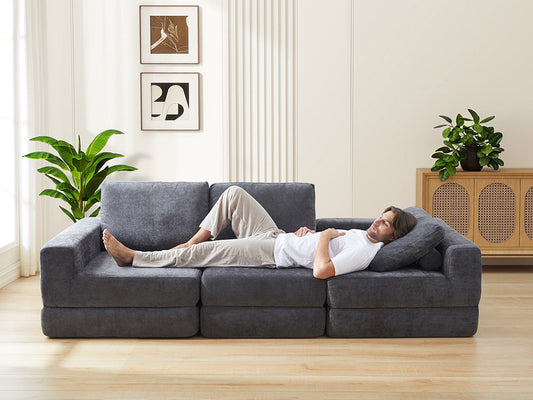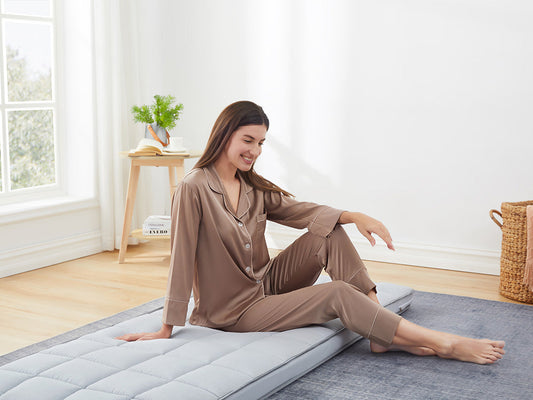In today’s fast-paced lifestyle, temporary sleep scenarios are increasingly common—whether preparing a guest room for occasional visitors or using a portable mattress for camping or short trips. A comfortable and practical temporary mattress is essential. High-resilience foam and memory foam, as two mainstream materials, are highly favored for their unique properties. However, how to choose between them? How does the mattress cover design impact the user experience? The following analysis from three aspects—material characteristics, comfort factors, and mattress cover design—will help you find the most suitable solution.
I. Mattress Material Selection: High-Resilience Foam vs. Memory Foam
1. High-Resilience Foam: Balance of Support and Rebound
High-resilience foam (HR foam) is renowned for its excellent support and rapid rebound. Its dense internal structure, typically with a density of 25kg/m³ or higher, evenly distributes body pressure and prevents localized sagging. For temporary sleep needs, the advantages of high-resilience foam include:
Broad Adaptability: Provides stable support for back, side, or stomach sleepers, ideal for those who prefer a firmer feel.
Superior Breathability: Open-cell structure facilitates airflow, reducing stuffiness, suitable for summer or humid environments.
Enhanced Durability: High-density material resists deformation and quickly regains shape after long-term folding or rolling.
2. Memory Foam: Synonymous with Contouring and Pressure Relief
Memory foam (also known as slow-rebound foam) molds to body curves through temperature sensitivity, offering a “customized” embrace. Its core benefits include:
Pressure Distribution: Precisely conforms to shoulders, lower back, and other pressure points, reducing discomfort during movement, ideal for spine-sensitive users.
Motion Isolation: Absorbs vibrations, minimizing disturbances from a partner’s movements, improving sleep quality for light sleepers.
Temperature Responsiveness: Slightly firmer in winter and softens with body heat in summer. Opt for versions with ventilation holes or gel layers to avoid heat retention.
Selection Advice:If portability and quick storage are priorities (e.g., camping), high-resilience foam is lighter and easier to maintain. For ultimate comfort and pressure relief (e.g., guest room use), memory foam is the superior choice.
II. Key Comfort Factors: Thickness, Density, and Firmness
1. Thickness Selection: Balancing Comfort and Portability
5-8cm: Suitable for layering on existing mattresses, lightweight and easy to store, but offers moderate support.
10-15cm: Provides sufficient support for standalone use, ideal for extended temporary needs (e.g., postpartum care beds).
2. Density and Firmness
High-Resilience Foam: Higher density enhances support. For temporary use, choose models with a density ≥30kg/m³ to prevent sagging.
Memory Foam: Optimal density ranges from 50-80kg/m³, balancing contouring without excessive sinkage.
High-Resilience Foam + Memory Foam Hybrid:
Combines the core strengths of both materials, delivering a medium-firm feel with balanced support and contouring.
3. Reinforced Edge Design
Premium temporary mattresses often feature high-density edge reinforcement to prevent sagging when sitting or lying near the edges, enhancing safety—especially for children or elderly users.
III. Mattress Cover: The "Second Skin" of Comfort
Though often overlooked, the mattress cover is critical to the user experience. An excellent cover should include:
1. Functional Design
Removable & Washable: Temporary mattresses are prone to dust and stains. Waterproof, stain-resistant fabrics (e.g., TPU coating) with zippered designs simplify cleaning.
Breathable & Antimicrobial: Bamboo fiber or silver-ion fabrics inhibit bacterial growth, ideal for allergy-prone users.
Non-Slip Base: Silicone dots or anti-slip stripes on the bottom prevent shifting during use.
2. Aesthetics and Texture
Patterns & Colors: Neutral tones or minimalist stripes blend seamlessly into home decor; brushed fabrics enhance skin-friendly comfort.
Hidden Handles: Integrated handles on portable models ease transportation without compromising aesthetics.
IV. Buying Checklist: 3 Steps to Your Ideal Mattress
1. Define Needs: Narrow options based on usage scenarios (e.g., travel, guest room) and sleep preferences (firmness level).
2. Test In-Store: Simulate sleeping positions (side, back) to assess rebound speed or body contouring.
3. Inspect Details: Check stitching quality, zipper smoothness, and certifications (e.g., CertiPUR-US for eco-friendly materials).
Conclusion
A high-quality temporary mattress is not just a sleep surface but an extension of lifestyle quality. Whether opting for the robust support of high-resilience foam or the gentle embrace of memory foam—paired with a scientifically designed cover—temporary sleep transitions from compromise to refinement. When selecting, prioritize material properties and craftsmanship over price alone, and discover the “silent guardian” that turns every temporary rest into a rejuvenating experience.








